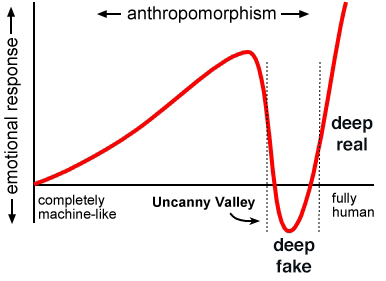
Deepfakes are a big thing, and a bad one.
On the big side, a Google search for deepfake brings up more than 23 billion results.
On the bad side, today’s top result in a search on Twitter for the hashtag #deepfake says, “Technology is slowly killing reality. I am worried of tomorrow’s truths that will be made in shops. This #deepfake is bothering my soul deeply.” In another of the top results, a Vice report is headlined Deepfake Porn Is Evolving to Give People Total Control Over Women’s Bodies.
Clearly we need an antidote here.
I suggest deepreal.
If deepfake lies at the bottom of the uncanny valley (as more than 37 thousand sites online suggest), deepreal should be just as highly out of that valley. As the graphic above (source) suggests, the deeply real (I added that) is fully human, and can elicit any level of emotional response, as real humans tend to do.
So what do we know that’s already deepreal?
Well, there’s reality itself, meaning the physical kind. A real person talking to you in the real world is undeniably human (at least until robots perfectly emulate human beings walking, talking and working among us, which will be icky and therefore deep in the uncanny valley). But what about the digital world? How can we be sure that a fully human being is also deeply real where the prevalent state is incorporeal—absent of physical existence?
The only way I know, so far, is with self-sovereign identity (SSI) technology, which gives us standardized ways of letting others know required facts about us (e.g. “I’m over 18,” “I’m a citizen of this country,” “I have my own car insurance,” “I live in this state,” “I’m a member of this club.”) Here’s some of what I’ve written and said about SSI:
- The Sovereign Identity Revolution (OneWorldIdentity, 21 February, 2017)
- New Hope for Digital Identity (Linux Journal, 9 November 2017)
- Some Thoughts About Self-Sovereign Identity (doc.blog, 16 March 2019)
- Some Perspective on Self-Sovereign Identity (KuppingerCole, 20 April 2019)
- Thoughts at #ID2020 (Doc Searls Weblog, 19 September 2019)
As I put it in #4 above, “The time has come to humanize identity in the networked world by making it as personal as it has been all along in the natural one.” I believe it is only by humanizing identity in the networked world that we can start to deal with deepfakes and other ways we are being dehumanized online. (And, if you’re skeptical about SSI, as are some I shouted out to here, what other means to you suggest? It’s still early, and the world of possibility is large.)
I also look forward to discussing this with real people here online—and in the physical world. Toward that, here are some identity tech gatherings coming up in 2020:
- KnowIdentity (April 5-8, in Las Vegas)
- EIC 2020 (12-15 May, in Munich)
- Internet Identity Workshop (28-30 April and 20-22 October)
- Others listed by IDpro
I also look forward to playing whack-a-mole with robots faking interest in this post; and which, because I’ll succeed, you’ll not see in the comment section below. (You probably also won’t see comments by humans, because humans prefer conversational venues not hogged by robots.)
Leave a Reply